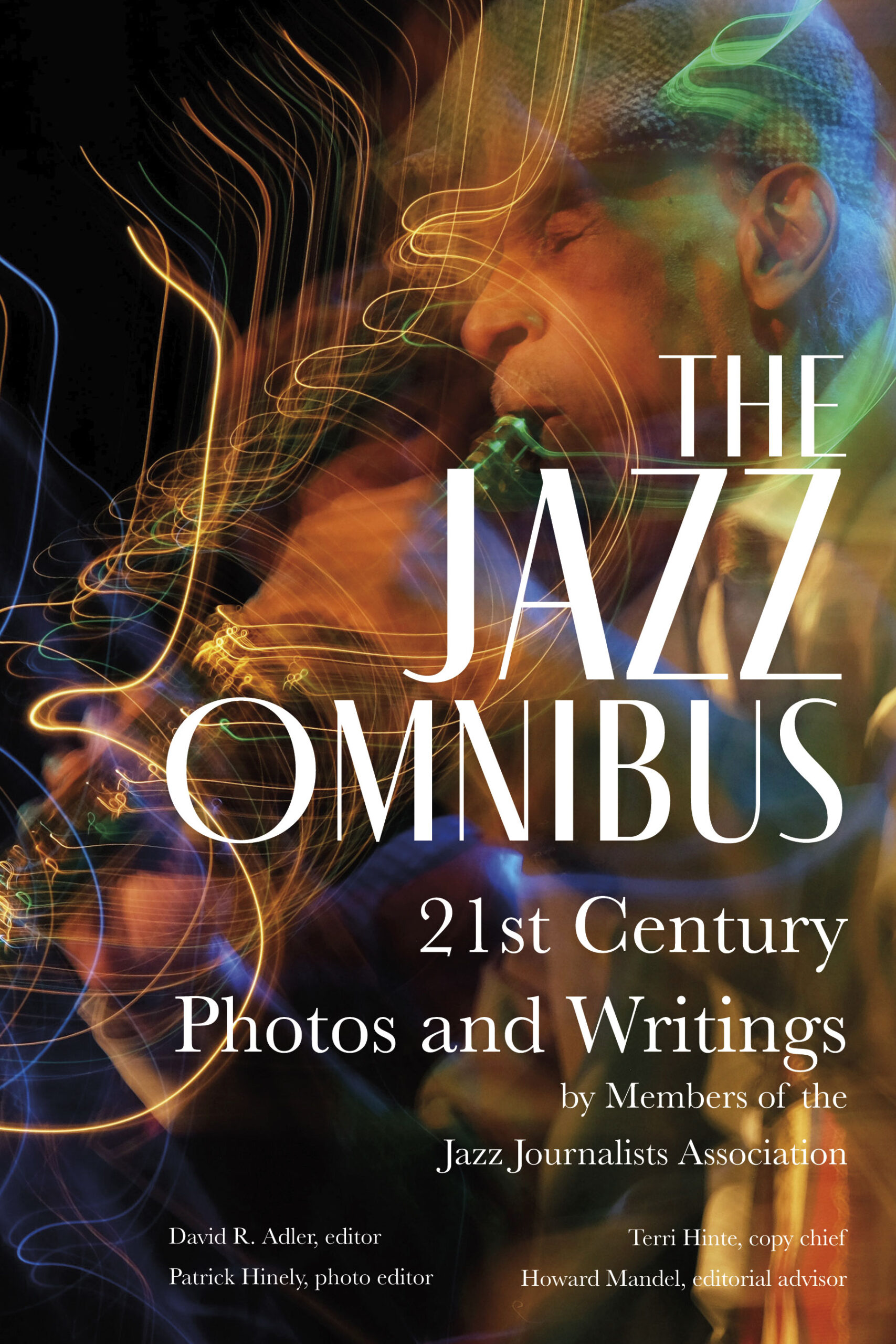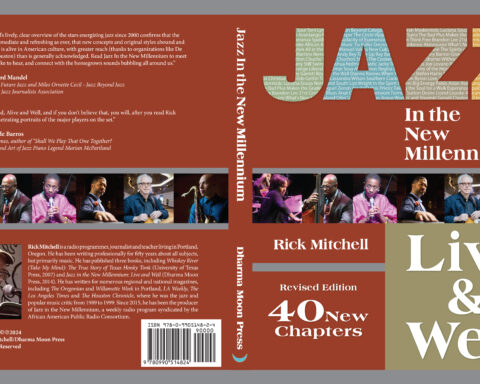
W. Royal Stokes, author most recently of three novels as well as four previous books on jazz, a founding member of the JJA and past editor of Jazz Notes, annually presents a roundup of books he’s received, posted on his on blog. Many but not all of them are related to jazz and/or other forms of music, “popular” or otherwise. Below are quotes from Stokes’ notes regarding some relevant volumes:
http://www.wroyalstokes.com/2017/12/26/a-roundup-by-w-royal-stokes-of-140-or-so-jazz-blues-beyond-and-other-books-published-in-the-past-year-or-so/
1) BIOGRAPHIES
Crescent City Slidemen, by Christopher Hillman, with Richard Rains and Mike Pointon “documents virtually all trombonists from New Orleans who have contributed to the city’s traditional music from the birth of jazz to the present day.” . . . Photographs, illustrations of 78RPM record labels and LP covers, discography, bibliography, index, and a CD of 25 tracks by trombonists from New Orleans.
Brendan Wolfe’s Finding Bix: The Life and Afterlife of a Jazz Legend (University Of Iowa Press) “is anything but straightforward, as Wolfe discovers Bix Beiderbecke to be at the heart of furious and ever-timely disputes over addiction, race and the origins of jazz, sex, and the influence of commerce on art.
Mezz Mezzrow’s and Bernard Wolfe’s Really the Blues (New York Review Books Classics) This welcome reissue has a perceptive introduction by jazz critic Ben Ratliff.
Fats Waller (University of Minnesota Press), by Maurice Waller and Anthony Calabrese, with a Foreword by Michael Lipskin, is a reissue of the 1997 edition [relating] the intimate, behind-the-scenes story of his exuberant life, as told by his son, Maurice Walle {of} .a family man, struggling to juggle domestic affairs with the demands of being one of the era’s busiest jazzmen. From his earliest days as a child prodigy to his wild nights playing Harlem rent parties to his appearances on stages around the world and his eventual commercial success . . .
Count Basie, Good Morning Blues: The Autobiography of Count Basie, as told to Albert Murray, with an Introduction by Dan Morgenstern. This reprint of the 1985 edition again “brings the voice of Count Basie to the printed page . . . ten years in the making.
Elaine M. Hayes, Queen of Bebop: The Musical Lives of Sarah Vaughan (Ecco/Harper Collins) “brilliantly chronicles the life of jazz singer Sarah Vaughan, one of the most influential and innovative musicians of the twentieth century and a pioneer of women’s and civil rights.. . This absorbing and sensitive treatment of a singular personality updates and corrects the historical record on Vaughan and elevates her status as a jazz great.
Jeroen de Valk’s Chet Baker: His life and music (Aspekt Publishers) is “the ultimate revised, updated and expanded edition [of] Baker’s first biography, published a year after Baker’s passing in 1988.
Rat Race Blues: The Musical Life of Gigi Gryce, by Noal Cohen and Michael Fitzgerald (Current Research in Jazz) Misinformation about Gryce abounds and rumors have circulated for decades. Years of research and dozens of interviews were conducted for this book, resulting in a biography that finally tells the true story of this often overlooked figure and illuminates his contributions to one of the richest periods in jazz history. Winner of the 2003 Award for Excellence from the Association for Recorded Sound Collections, the first edition has now been updated with new information from another decade’s worth of research and never-before-seen photographs.”
Lillian Terry’s Brother Ray, and Friends: On and Off the Record with Jazz Greats “offers readers a rare opportunity to hear intimate conversations with some of the world’s greatest musical figures. Dizzy Gillespie . . .Duke Ellington . . . Ray Charles . . .Abbey Lincoln, Max Roach, Horace Silver, Bill Evans . . .unforgettable encounters.”
Mark Miller, Claude Ranger: Canadian Jazz Legend (Mark Miller). “Even before Claude Ranger disappeared in late 2000, his fate unknown, he had attained legendary status among Canada’s jazz musicians as an extraordinary drummer who repeatedly challenged the status quo on bandstands in Montreal, Toronto and Vancouver. . .a sympathetic portrait of this remarkable musician and offers a perceptive overview of the Canadian jazz scene during the 35 years in which, by turns, his career flourished, faltered and flourished again.’
He’s Got Rhythm: The Life and Career of Gene Kelly (Screen Classics) (University Press of Kentucky), by Cynthia Brideson and Sara Brideson, is “the first comprehensive biography written since the legendary star’s death. Authors Cynthia Brideson and Sara Brideson disclose new details of Kelly’s complex life. . . his contributions to the world of entertainment in depth [and] his political activities―including his opposition to the Hollywood blacklist.
Portrait of a Phantom: The Story of Robert Johnson’s Lost Photograph (Pelican Publishing Company, Inc.), by Zeke Schein and Poppy Brite. “Two young black men stared back at Zeke Schein from what seemed to be another time. They stood against a plain backdrop wearing snazzy suits, hats, and self-conscious smiles. The man on the left held a guitar stiffly against his lean frame. . . . ‘That’s not B. B. King, Schein,’ said to himself. ‘Because it’s Robert Johnson’. . . . Bluesman John Hammond: “The details and anecdotes herein give a great perspective to ‘the Phantom.’”
Mitsutoshi Inaba’s John Lee “Sonny Boy” Williamson: The Blues Harmonica of Chicago’s Bronzeville (Roots of American Music: Folk, Americana, Blues, and Country) (Rowman & Littlefield Publishers) “offers the first full-length biography of this key figure in the evolution of the Chicago blues. how Sonny Boy lived through the lineage of blues harmonica performance, drawing on established traditions and setting out a blueprint for the growing electric blues scene. Interviews with Sonny Boy’s family members and his last harmonica student provide new insights into the character of the man as well as the techniques of the musician.”
Dance of Death: The Life of John Fahey, American Guitarist (Chicago Review Press, 2014), by Steve Lowenthal, with a Preface by David Fricke, “the first major historical and critical biography” of a musician [who] is to the solo acoustic guitar what Jimi Hendrix was to the electric: the man whom all subsequent musicians had to listen to. . . This portrait of a troubled and troubling man in a constant state of creative flux is not only a biography but also the compelling story of a great American outcast.”
In the Midnight Hour: The Life & Soul of Wilson Pickett (Oxford University Press), by Tony Fletcher. “For this first-ever accounting of Wilson Pickett’s life, bestselling biographer Tony Fletcher interviewed members of the singer’s family, friends and partners, along with dozens of his studio and touring musicians. Offering equal attention to Pickett’s personal and professional life, with detailed insight into his legendary studio sessions and his combative road style . . .
Jean R. Freedman’s Peggy Seeger: A Life of Music, Love, and Politics (University of Illinois Press)Seeger’s multifaceted career, from her youth to her pivotal role in the American and British folk revivals, from her instrumental virtuosity to her tireless work on behalf of environmental and feminist causes, from wry reflections on the U.K. folk scene to decades as a songwriter… creating the renowned Festivals of Fools, founding Blackthorne Records, masterminding the legendary Radio Ballads documentaries, and mentoring performers in the often-fraught atmosphere of The Critics Group.
David Yaffe’s Reckless Daughter: A Portrait of Joni Mitchell (Sarah Crichton Books/Farrar, Straus and Giroux) “reveals the backstory behind the famous songs―from Mitchell’s youth in Canada, her bout with polio at age nine, and her early marriage and the child she gave up for adoption, through the love affairs that inspired masterpieces, and up to the present―and shows us why Mitchell has so enthralled her listeners, her lovers, and her friends.
Peter Ames Carlin Homeward Bound: The Life of Paul Simon (Henry Holt and Co.). “[Paul] Simon has . . . lived one of the most vibrant lives of modern times; a story replete with tales of Carrie Fisher, Leonard Bernstein, Bob Dylan, Woody Allen, Shelley Duvall, Nelson Mandela, drugs, depression, marriage, divorce, and more. A life story with the scope and power of an epic novel,
I Am Brian Wilson: A Memoir (Da Capo Press), by Brian Wilson with Ben Greenman, “reveals as never before the man who fought his way back to stability and creative relevance, who became a mesmerizing live artist, who forced himself to reckon with his own complex legacy, and who finally completed Smile, the legendary unfinished Beach Boys record that had become synonymous with both his genius and its destabilization.
Jonathan Eig’s Ali: A Life (Houghton Mifflin Harcourt) is “The definitive biography of an American icon, from a New York Times best-selling author with unique access to Ali’s inner circle.
2) PHOTOGRAPHY COLLECTIONS, HISTORY, REFERENCE, CRITICISM, ETC.
50 YEARS AT THE VILLAGE VANGUARD: Thad Jones, Mel Lewis and the Vanguard Jazz Orchestra (skydeckmusic.com), by Dave Lisik and Eric Allen, includes “Hundreds of rare photographs, and many images of rare memorabilia such as posters, concert tickets, vintage advertisements and tour itineraries. In depth featured on Mel Lewis and the music of Thad Jones, Bob Brookmeyer and Jim McNeely. Profiles of all current members of The Vanguard Orchestra. Complete listing of personnel throughout the band’s entire history. Exclusive coverage and photographs of the 50th anniversary celebration.”
This 40th Anniversary reprint of Albert Murray’s Stomping the Blues (University Of Minnesota Press), with an introduction by Paul Devlin “explores its history, influences, development, and meaning as only he can. More than two hundred vintage photographs capture the ambiance Murray evokes in lyrical prose.
Jerry Dantzic’s and Grayson Dantzic’s Jerry Dantzic: Billie Holiday at Sugar Hill (Thames & Hudson/W. W. Norton), with a reflection by author Zadie Smith. “In 1957, New York photojournalist Jerry Dantzic spent time with the iconic singer Billie Holiday during a week-long run of performances at the Newark, New Jersey, nightclub Sugar Hill. The resulting images offer a rare behind-the-scenes glimpse of Billie with her family, friends, and her pet chihuahua, Pepe; playing with her godchild (son of her autobiography’s co-author, William Dufty); washing dishes at the Duftys’ home; walking the streets of Newark; in her hotel room; waiting backstage or having a drink in front of the stage; and performing. . . Only a handful of the photographs in the book have ever been published. In her text, Zadie Smith evokes Lady Day herself and shows us what she sees as she inhabits these images and reveals what she is thinking. 90 illustrations.”
Barbara Kukla’s The Encyclopedia of Newark Jazz (Swing City Press, bjkukla@aol.com) “includes more than 300 capsule biographies of Newark jazz musicians and singers, most with photos.Kukla worked at The Star-Ledger for 38 years, most of that time as editor of the popular ‘Newark This Week’ section.
Paul Steinbeck’s Message to Our Folks: The Art Ensemble of Chicago (University Of Chicago Press) “marks the golden anniversary of the Art Ensemble of Chicago, the flagship band of the Association for the Advancement of Creative Musicians [AACM]. [The author] combines musical analysis and historical inquiry to give us the definitive study of the Art Ensemble. In the book, he proposes a new theory of group improvisation that explains how the band members were able to improvise together in so many different styles while also drawing on an extensive repertoire of notated compositions. Steinbeck examines the multimedia dimensions of the Art Ensemble’s performances and the ways in which their distinctive model of social relations kept the group performing together for four decades.
Vinyl Freak: Love Letters to a Dying Medium (Duke University Press) “music writer, curator, and collector John Corbett burrows deep inside the record fiend’s mind, documenting and reflecting on his decades-long love affair with vinyl . . . composed in part of Corbett’s long-running Down Beat magazine column of the same name, which was devoted to records that had not appeared on CD.
Soul Jazz: Jazz in the Black Community, 1945-1975 (Xlibris Corp.), by Bob Porter, “is a history of jazz and its reception in the black community in the period from the end of World War II until the end of the Vietnam War. Previous histories reflect the perspective of an integrated America, yet the United States was a segregated country in 1945. The black audience had a very different take on the music and that is the perception explored in Soul Jazz.”
Martin Torgoff’s Bop Apocalypse: Jazz, Race, the Beats, and Drugs (Da Capo Press) — “. . .details the rise of early drug culture in America by weaving together the disparate elements that formed this new and revolutionary segment of the American social fabric. . . . the birth of jazz in New Orleans, the first drug laws, Louis Armstrong, Mezz Mezzrow, Harry Anslinger and the Federal Bureau of Narcotics, swing, Lester Young, Billie Holiday, the Savoy Ballroom, Reefer Madness, Charlie Parker, the birth of bebop, the rise of the Beat Generation, and the coming of heroin to Harlem.
Carolyn Glenn Brewer’s Changing the Tune: The Kansas City Women’s Jazz Festival, 1978-1985 (University of North Texas Press) For the first book about this groundbreaking festival, Carolyn Glenn Brewer interviewed dozens of people and dove deeply into the archives. This book is an important testament to the ability of two friends to emphatically prove jazz genderless, thereby changing the course of jazz history.”
Michael C. Heller’s Loft Jazz: Improvising New York in the 1970s (University of California Press) “The New York loft jazz scene of the 1970s . . . , a pivotal period for uncompromising, artist-produced work. Faced with a flagging jazz economy, a group of young avant-garde improvisers chose to eschew the commercial sphere and develop alternative venues in the abandoned factories and warehouses of Lower Manhattan. . . history amid a series of overlapping discourses surrounding collectivism, urban renewal, experimentalist aesthetics, underground archives, and the radical politics of self-determination.’
Michael Stephans’ Experiencing Ornette Coleman: A Listener’s Companion (Rowman & Littlefield Publishers) “explores the personal challenges Coleman faced, the music he created from one decade to the next, and the incredibly positive attitude he maintained in the face of so much negativity throughout his life.
Monika Herzig’s Experiencing Chick Corea: A Listener’s Companion (Rowman & Littlefield Publishers) “looks at the full span of Corea’s career, decade by decade, touching on the vast array of musical styles he engaged, from his initial work with Herbie Mann to his free explorations with Circle. . . Experiencing Chick Corea introduces this American Icon to audiences beyond the domain of jazz fans already familiar with this work.
Charles Hersch’s Jews and Jazz: Improvising Ethnicity (Transnational Studies in Jazz) (Routledge) ‘explores the meaning of Jewish involvement in the world of American jazz. The author looks at Jewish identity through jazz in the context of the surrounding American culture, believing that American Jews have used jazz to construct three kinds of identities: to become more American, to emphasize their minority outsider status, and to become more Jewish.
Anna Harwell Celenza’s Jazz Italian Style: From its Origins in New Orleans to Fascist Italy and Sinatra (Cambridge University Press) “explores a complex era in music history, when politics and popular culture collided with national identity and technology. . . the book recovers a lost repertoire and an array of musicians whose stories and performances are compelling and well worth remembering.”
Elizabeth Vihlen McGregor’s Jazz and Postwar French Identity: Improvising the Nation (Lexington Books/Rowman & Littlefield Publishing Group). “In the context of a shifting domestic and international status quo that was evolving in the decades following World War II, French audiences used jazz as a means of negotiating a wide range of issues that were pressing to them and to their fellow citizens. Despite the fact that jazz was fundamentally linked to the multicultural through its origins in the hands of African-American musicians, happenings within the French jazz public reflected much about France’s postwar society.
John Lowney’s Jazz Internationalism: Literary Afro-Modernism and the Cultural Politics of Black Music (New Black Studies Series) (University of Illinois Press) “offers a bold reconsideration of jazz’s influence in Afro-modernist literature. Ranging from the New Negro Renaissance through the social movements of the 1960s, John Lowney articulates nothing less than a new history of Afro-modernist jazz writing. Jazz added immeasurably to the vocabulary for discussing radical internationalism and black modernism in leftist African American literature.
The Bohemian South: Creating Countercultures, from Poe to Punk (University of North Carolina Press), edited by Lindsey A. Freeman. “From the southern influence on nineteenth-century New York to the musical legacy of late-twentieth-century Athens, Georgia, to the cutting-edge cuisines of twenty-first-century Asheville, North Carolina, the bohemian South has long contested traditional views of the region. . . .This timely and illuminating collection uses bohemia as a novel lens for reconsidering more traditional views of the South.
John Gennari’s Flavor and Soul: Italian America at Its African American Edge (University Of Chicago Press) tells how ‘In the United States, African American and Italian cultures have been intertwined for more than a hundred years. From as early as nineteenth-century African American opera star Thomas Bowers—‘The Colored Mario’—all the way to hip-hop entrepreneur Puff Daddy dubbing himself ‘the Black Sinatra,’ the affinity between black and Italian cultures runs deep and wide.
Bill Dahl’s and Chris James’s (Art Consultant) The Art of the Blues: A Visual Treasury of Black Music’s Golden Age (University Of Chicago Press) ‘charts the rich history of the blues, through the dazzling a “ray of posters, album covers, and advertisements that have shaped its identity over the past hundred years. a fascinating visual documentation of the music industry as well as insight into American culture
Julian Piper’s Blues from the Bayou: The Rhythms of Baton Rouge (Pelican Publishing Company, Inc.) is an “intensely personal and entertaining account [and] a snapshot of Blues from an outsider welcomed into the inner circles of Southern Blues icons.
The Blues Why It Still Hurts So Good (Yakkabiz Publishers), by Marie B. Trout, “to some contemporary fans, the blues is still life-saving and sanity-restoring, for others it provides access to cathartic and mood-enhancing elements, but for all it offers a break to just let go and be.” a monumental discourse into the mysteries and pleasures of the blues” — John Mayall,
Joshua Jelly-Schapiro’s Island People: The Caribbean and the World (Knopf) is “A masterwork of travel literature and of history: voyaging from Cuba to Jamaica, Puerto Rico to Trinidad, Haiti to Barbados, and islands in between, Joshua Jelly-Schapiro offers a kaleidoscopic portrait of each society, its culture and politics, connecting this region’s common heritage to its fierce grip on the world’s imagination. people, scattered across a vast archipelago and separated by the languages of their colonizers, have nonetheless together helped make the modern world—its politics, religion, economics, music, and culture.
Marc Myers’s Anatomy of a Song: The Oral History of 45 Iconic Hits That Changed Rock, R&B and Pop (Grove Press) “songwriters and performers speak in their own voices, edited from interviews with Myers, about one of their signature songs. Because of Myers’s skill as an interviewer, their pride and enthusiasm come blasting through. Each story is a pleasure to read and will deepen your listening experience . . . Myers bears down hard on these songs and the artists rise to the standards he sets.” Anthony DeCurtis, New York Times Book Review
Rick Massimo’s I Got a Song: A History of the Newport Folk Festival (Wesleyan University Press) is “The first-ever book exclusively devoted to the history of the Newport Folk Festival, I Got a Song documents the trajectory of an American musical institution that began more than a half-century ago and continues to influence our understanding of folk music today.
Listening for the Secret: The Grateful Dead and the Politics of Improvisation (Studies in the Grateful Dead) (University of California Press) by Ulf Olsson and Nicholas Meriwether “With roots in popular music traditions, improvisation, and the avant-garde, the Grateful Dead provides a unique lens through which we can better understand the meaning and creation of the counterculture community. Marshaling the critical and aesthetic theories of Adorno, Benjamin, Foucault and others, Ulf Olsson places the music group within discourses of the political, specifically the band’s capacity to create a unique social environment.
Love for Sale: Pop Music in America. David Hajdu (Farrar, Straus and Giroux) “draws on a lifetime of listening, playing, and writing about music to show how pop has done much more than peddle fantasies of love and sex to teenagers. From vaudeville singer Eva Tanguay, the ‘I Don’t Care Girl’ who upended Victorian conceptions of feminine propriety to become one of the biggest stars of her day to the scandal of Blondie playing disco at CBGB, Hajdu presents an incisive and idiosyncratic history of a form that has repeatedly upset social and cultural expectations.
Sean Kay’s Rockin’ the Free World!: How the Rock & Roll Revolution Changed America and the World (Rowman & Littlefield Publishers) “takes readers inside ‘Bob Dylan’s America’ and shows how this vision linked the rock and roll revolution to American values of freedom, equality, human rights, and peace while tracing how those values have spread globally. built around primary interviews with prominent American and international performing artists ranging from Rock and Roll Hall of Fame inductees and Grammy winners to regional and local musicians. The interviews include leading industry people, management, journalists, heads of non-profits, and activists.
Judy Kutulas’s After Aquarius Dawned: How the Revolutions of the Sixties Became the Popular Culture of the Seventies (University of North Carolina Press) “complicates the common view that the 1970s were a time of counterrevolution against the radical activities and attitudes of the previous decade. Instead, Kutulas argues that the experiences and attitudes that were radical in the 1960s were becoming part of mainstream culture in the 1970s, as sexual freedom, gender equality, and more complex notions of identity, work, and family were normalized through popular culture–television, movies, music, political causes, and the emergence of new communities.
Adrienne Trier-Bieniek’s The Beyoncé Effect: Essays on Sexuality, Race and Feminism (McFarland) “presents a detailed study of the music and persona of Beyoncé—arguably the world’s biggest pop star. Topics include the body politics of respectability; feminism, empowerment and gender in Beyoncé’s lyrics; black female pleasure; and the changing face of celebrity motherhood.
Joseph C. Ewoodzie Jr. Break Beats in the Bronx: Rediscovering Hip-Hop’s Early Years (University of North Carolina Press). Ewoodzie portrays the creative process that brought about what we now know as hip-hop and shows that the art form was a result of serendipitous events, accidents, calculated successes, and failures that, almost magically, came together. In doing so, he questions the unexamined assumptions about hip-hop’s beginnings, including why there are just four traditional elements—DJing, MCing, breaking, and graffiti writing—and not others, why the South Bronx and not any other borough or city is considered the cradle of the form, and which artists besides Kool Herc, Afrika Bambaataa, and Grandmaster Flash founded the genre.
Alejandro Nava’s In Search of Soul: Hip-Hop, Literature, and Religion (University of California Press) “explores the meaning of ‘soul’ in sacred and profane incarnations, from its biblical origins to its central place in the rich traditions of black and Latin history. Surveying the work of writers, artists, poets, musicians, philosophers and theologians, Alejandro Nava shows how their understandings of the ‘soul’ revolve around narratives of justice, liberation, and spiritual redemption.
In The Sound of Navajo Country: Music, Language, and Diné Belonging (University of North Carolina Press), “an ethnography of Navajo (Diné) popular music culture,” Kristina M. Jacobsen “examines questions of Indigenous identity and performance by focusing on the surprising and vibrant Navajo country music scene. Through multiple first-person accounts, Jacobsen illuminates country music’s connections to the Indigenous politics of language and belonging, examining through the lens of music both the politics of difference and many internal distinctions Diné make among themselves and their fellow Navajo citizens.
Marian Wilson Kimber’s The Elocutionists: Women, Music, and the Spoken Word (University of Illinois Press) “restores elocution with music to its rightful place in performance history. . . . Emerging in the 1850s, elocutionists recited poetry or drama with music to create a new type of performance. The genre—dominated by women—achieved remarkable popularity. Yet the elocutionists and their art fell into total obscurity during the twentieth century. . . . Gazing through the lenses of gender and genre, Wilson Kimber argues that these female artists transgressed the previous boundaries between private and public domains. Their performances advocated for female agency while also contributing to a new social construction of gender.
Tim Rutherford-Johnson’s Music after the Fall: Modern Composition and Culture since 1989 (University of California Press) “is the first book to survey contemporary Western art music within the transformed political, cultural, and technological environment of the post–Cold War era. In this book, Tim Rutherford-Johnson considers musical composition against this changed backdrop, placing it in the context of globalization, digitization, and new media. Drawing connections with the other arts, in particular visual art and architecture, he expands the definition of Western art music to include forms of composition, experimental music, sound art, and crossover work from across the spectrum, inside and beyond the concert hall.





